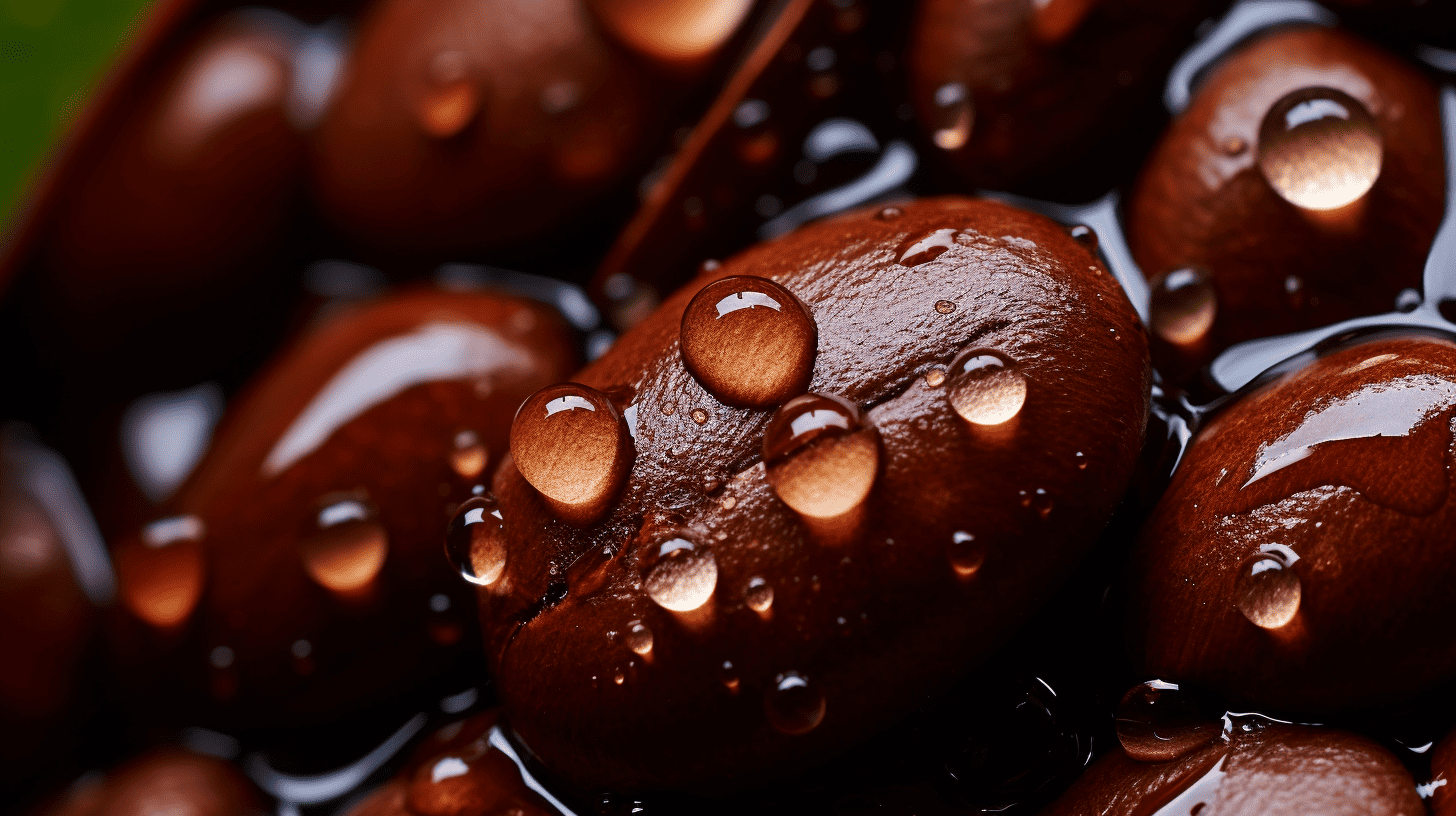Black coffee and white coffee are two popular coffee choices that differ in terms of their calorie content. Comparing black coffee vs white coffee calories; black coffee wins and is a zero-calorie beverage that contains only water and coffee beans. This means that it doesn’t add any extra calories to your diet, making it an ideal choice for those who are trying to lose weight or maintain a healthy lifestyle.
White coffee, on the other hand, is made by adding milk and sugar to black coffee, which increases its calorie count. The calorie content of white coffee can vary depending on the type of milk and amount of sugar added. For example, a cup of white coffee made with whole milk and two teaspoons of sugar can contain up to 70 calories.
How Many Calories Are In Each Type of Coffee
| Coffee Drink | Calories per Cup |
|---|---|
| Black Coffee | Approximately 200-420 calories, depending on the size and amount of cream used |
| Espresso | 3 calories |
| Americano | 5 calories |
| Cold Brew Coffee | 3 calories |
| Brewed Coffee from Flavored Beans | 2 calories |
| Iced Black Coffee | 2 calories |
| Coffee with 1 tablespoon of French Vanilla Creamer | 32 calories |
| Cappuccino (8 ounces) | 80 calories |
| Latte (16 ounces) | 190 calories |
| Coffee with Whole Milk | 21 calories |
| Coffee with Whole Milk and 1 Sugar | 45 calories |
| Coffee with Cream | Approximately 200-420 calories, depending on the size and amount of cream used. |
If you enjoy drinking multiple cups of coffee throughout the day, switching from white to black could significantly reduce your daily calorie intake. By choosing black coffee over white, you’ll consume fewer calories without sacrificing the taste or flavor.
It’s important to be mindful of the calorie content of your drinks, especially if you’re trying to maintain a healthy diet. Many people don’t realize how many calories they consume daily through their beverages alone. By making simple swaps like switching from white to black coffee, you can make a big difference in your overall calorie intake.
In addition to being lower in calories than white coffee, black coffee also has several other health benefits. It’s been shown to improve cognitive function, boost metabolism, and even lower the risk of certain diseases like Parkinson’s and Alzheimer’s.
When it comes down to it, choosing between coffee black and white coffee ultimately comes down to personal preference. If you enjoy the taste of creamy lattes or sweetened coffees, there’s no harm in indulging occasionally – just be mindful of how often you’re consuming these higher-calorie options.
Understanding Calories and How Many You Need Per Day
Factors Affecting Calorie Intake
Age, gender, weight, height, and physical activity level are the main factors that determine how many calorie counts you need per day. Younger people generally require more calories than older individuals because they have a higher metabolism. Men typically need more calories than women due to their larger body size and muscle mass. Taller individuals also require more calories since they maintain a greater surface area.
Physical activity level is another important factor in determining calorie needs. Those who lead an active lifestyle or exercise regularly burn more calories than sedentary individuals. The amount of energy expended during exercise depends on the type of activity, duration, and intensity.
Key Takeaways On Caloric Intake:
- Caloric intake refers to the number of calories a person consumes daily. Balancing caloric intake with energy expenditure is vital for maintaining a healthy weight.
- Different food groups contribute different amounts of calories. Proteins and carbohydrates provide 4 calories per gram, while fats provide 9 calories per gram.
- Consuming more calories than the body needs can lead to weight gain, while consuming fewer can lead to weight loss.
- Not all calories are created equal. Calories from whole, nutrient-dense foods promote better health than calories from processed, sugary foods.
- It’s important to consider the nutritional content of food, not just the calorie count. A balanced diet includes a variety of foods from all food groups.
- Regular physical activity is a key part of managing caloric intake and maintaining a healthy weight.
- It’s recommended to consult with a healthcare provider or dietitian to determine the appropriate daily caloric intake based on individual health needs and goals.
Calorie Counting for Weight Loss
To lose weight, you must consume fewer calories than your body burns daily. A safe rate of weight loss is 1-2 pounds per week, which requires a daily calorie deficit of 500-1000 calories. However, it’s important not to restrict your calorie intake too much as this can slow down your metabolism and make it harder to lose weight.
Instead of drastically cutting your calorie intake, focus on making healthier food choices and increasing physical activity levels. Aim for a balanced diet with plenty of fruits and vegetables, whole grains, lean protein sources like chicken or fish, and healthy fats such as avocado or nuts.
The Benefits of Black Coffee
Black coffee without added sugar or cream is a low-calorie beverage that provides energy and health benefits for many people. One cup of black coffee contains only two calories but can help boost metabolism and improve mental alertness.
Studies have shown that caffeine can increase metabolic rate by up to 11%, leading to greater fat burning potential during exercise. Black coffee contains antioxidants that may help reduce inflammation in the body and lower the risk of chronic diseases like heart disease or cancer.
The Minimal Calories in Plain Brewed Coffee
Plain coffee brew is a popular beverage around the world. Not only does it provide an energy boost, but it also has minimal calories. In fact, a typical 8-ounce cup of plain brewed coffee contains only 2 calories. This makes plain brewed coffee an excellent option for those who are watching their calorie intake.
Low-Calorie Content of Plain Brewed Coffee
The low-calorie content of plain brewed coffee can be attributed to its simple preparation process. Unlike other types of coffee drinks, such as lattes or cappuccinos, plain brewed coffee is made by simply brewing ground coffee beans with hot water. The low-temperature brewing process helps preserve the drink’s low-calorie content.
Moreover, plain brewed coffee contains no added sugar or creamer that could increase its calorie count. It’s worth noting that adding sugar and creamer to your cup of plain brewed coffee will increase its calorie count significantly.
Benefits of Drinking Plain Brewed Coffee
Apart from being a low-calorie drink, plain brewed coffee has several other benefits. For one, it contains antioxidants that help protect your body against free radicals and reduce inflammation. Caffeine in plain brewed coffee can improve mental alertness and enhance physical performance.
Another benefit of drinking plain brewed coffee is that it can help you lose weight. Caffeine in the drink acts as a natural appetite suppressant that can reduce your food cravings and help you eat less throughout the day.
Milk and Sugar’s Effect on Coffee Calories
Coffee is a popular beverage consumed worldwide, with many people preferring to add milk and sugar to their coffee for the taste. However, adding these ingredients can significantly increase the calorie count of your coffee. In this section, we will discuss how milk and sugar affect the calorie count of coffee.
Milk’s Effect on Coffee Calories
Adding milk to your coffee can increase its calorie count depending on the type of milk used. Whole milk contains more calories than other types of milk, such as skimmed or low-fat milk. For instance, one cup (240 ml) of whole milk contains 149 calories, while one cup (240 ml) of skimmed or low-fat milk contains only 83 calories.
Moreover, flavored syrups such as vanilla or caramel syrup are high in calories and can significantly increase the calorie count of your coffee. A tablespoon (15 ml) of vanilla syrup contains about 50 calories, while a tablespoon (15 ml) of caramel syrup contains approximately 52 calories.
However, you can reduce the calorie count by opting for low-fat or skimmed milk instead of whole milk. Using unsweetened almond or soy milk as an alternative to cow’s milk is also an excellent way to reduce the calorie count in your coffee.
Sugar’s Effect on Coffee Calories
Sugar is another ingredient that can significantly increase the calorie count in your coffee. One teaspoon (4 grams) of sugar contains approximately 16 calories. Therefore, adding two teaspoons (8 grams) of sugar to your coffee increases its calorie content by 32 calories.
Furthermore, some people prefer using artificial sweeteners like Splenda or Stevia instead of natural sugar because they contain fewer calories. However, it is essential to note that artificial sweeteners may have side effects when consumed in large quantities.
Reducing Calorie Count in Your Coffee
If you are watching your weight or trying to maintain a healthy lifestyle, you can reduce the calorie count in your coffee by opting for black coffee or low-fat milk and sugar substitutes. Here are some reasons to help you lower the calorie count in your coffee.
Nutritional Information of Different Coffee Drinks
Plain black coffee is a low-calorie beverage that can be enjoyed any time of the day. It contains only 2 calories in an 8 oz cup and has no fat, cholesterol, or sodium. However, adding cream, sugar, or other flavorings can quickly increase the calorie count. For example, a cup of coffee with one tablespoon of cream and one teaspoon of sugar contains around 40 calories.
Popular coffee drinks like lattes, cappuccinos, and mochas often contain added sugars and syrups which can significantly increase their calorie count. A typical latte made with whole milk and flavored syrup can contain up to 300 calories per serving. Similarly, a mocha made with chocolate syrup and whipped cream can have over 400 calories per serving.
If you are looking for a low-calorie option when ordering your favorite coffee drink at a café or restaurant, consider ordering it with skim milk instead of whole milk or cream. Skim milk has fewer calories than whole milk while still providing the same amount of calcium and protein.
The caffeine content also varies between coffee drinks. A typical 8 oz cup of drip coffee contains around 95 mg of caffeine, while a shot of espresso contains around 63 mg of caffeine. The difference in caffeine content between different types of coffee drinks is due to the difference in brewing methods used to make them.
It is important to note that drinking too much caffeine can lead to negative side effects such as increased heart rate, anxiety, and insomnia. The recommended daily limit for caffeine intake is around 400 mg daily for most adults.
Exploring Different Types of High-Calorie Espresso Drinks
Espresso is a popular coffee drink that millions of people around the world have enjoyed for many years. This concentrated coffee is made by forcing hot water through finely-ground coffee beans at high temperatures, creating a rich and intense flavor many people love. However, espresso drinks can also be relatively high in calories, especially when made with additional ingredients like milk or chocolate syrup.
Latte: A High-Calorie Espresso Drink
One of the most popular types of espresso drinks is the latte, which is made with steamed milk and espresso. While lattes can be delicious and satisfying, they can also be quite high in calories due to the addition of milk. Depending on the size and type of milk used, a typical latte can contain anywhere from 120 to 400 calories per serving.
You can do several things to reduce the calorie count of your latte without sacrificing taste. For example, you could try using skim or almond milk instead of whole milk, which will significantly reduce your drink’s fat and calories. You could also ask for less syrup or skip it altogether if you prefer a less sweet drink.
Mocha: A Chocolatey Twist on Espresso
Another popular type of espresso drink is the mocha, which includes chocolate syrup or powder in addition to steamed milk and espresso. While mochas are undeniably delicious, they can also be incredibly high in calories due to their sugary ingredients.
If you’re trying to watch your calorie intake but still want to enjoy a mocha now, and then, you can follow some simple tips. For example, you could ask for your mocha with skim or almond milk instead of whole milk to reduce its calorie count. You could also ask for less chocolate syrup or powder if you prefer a more subtle chocolate flavor.
Temperature: How It Affects Taste (and Calories)
One thing that many people don’t realize is that the temperature of your espresso drink can affect its taste and calorie content. Drinks made with espresso are typically served at higher temperatures than regular coffee, which can make them taste stronger and more bitter.
However, serving your espresso drink at a lower temperature could help to reduce its calorie count. This is because hot drinks tend to be consumed more quickly than cold ones, which means you may drink more calories without even realizing it.
Healthier Options for White Coffee: Plant-Based Milk or Dairy?
Dairy-based milk contains higher calories and fat compared to plant-based milk. Whole milk and cream milk are high in saturated fat, which can increase the risk of heart disease. Skimmed milk is better for those who want to reduce calorie intake and maintain a healthy weight.
Skimmed Milk: A Healthier Option
If you enjoy white coffee, you might wonder what type of milk is best for a creamer. While whole or cream milk may be delicious, they contain high amounts of saturated fat that can lead to health problems. Skimmed milk, on the other hand, is a much healthier option for those looking to reduce their calorie intake and maintain a healthy weight.
Skimmed milk contains significantly fewer calories than whole or cream milk while providing all the essential nutrients your body needs. It’s also an excellent source of protein, calcium, and vitamin D, making it an ideal choice for anyone looking to improve their overall health.
Plant-Based Milk: A Good Alternative
For those who are lactose intolerant or vegan, plant-based milks such as almond, soy, or oat milk are good alternatives to dairy-based milks. These types of milks are made from plants rather than animals and provide many of the same nutritional benefits as dairy-based milks without any of the adverse health effects.
In addition to being healthier for your body, choosing a plant-based milk over a dairy-based one is also good for the environment. Plant-based milks have a lower carbon footprint than dairy-based ones since they require less water and land resources to produce.
White Beans: A Surprising Substitute
If you’re looking for an even healthier option than skimmed or plant-based milks, consider using white beans as a substitute for creamer in your white coffee. White beans provide an excellent source of protein and fiber while containing very little fat or calories.
To use white beans as a creamer substitute, blend them with some water until they reach a creamy consistency. Add this mixture to your white coffee for a healthier and more nutritious drink.
Added Sugars in Sweetened Coffee Drinks
Sugar is a common ingredient added to coffee drinks to sweeten the taste. However, consuming too much sugar can harm one’s health. Sweetened coffee drinks contain added sugars that significantly increase the calorie count of the beverage. This section will discuss the dangers of added sugars in sweetened coffee drinks.
Added Sugars and Health Problems
Consuming too much sugar can lead to health problems such as obesity, diabetes, and heart disease. According to a study conducted by Harvard University, people who consume sugary beverages regularly are more likely to develop type 2 diabetes than those who do not. Excessive sugar consumption can lead to weight gain and obesity, increasing heart disease risk.
It is important to note that not all sugars are created equal. Natural sugars found in fruits and vegetables benefit our bodies as they come with vitamins and minerals that our bodies need. However, added sugars found in processed foods and sweetened beverages provide no nutritional value but only add calories.
Negating Health Benefits of Coffee
Coffee contains antioxidants that help protect cells from damage caused by free radicals. Antioxidants also reduce inflammation and lower the risk of chronic diseases such as cancer and Alzheimer’s disease. However, adding sugar to coffee can negate some of these potential health benefits.
According to a study published in The Journal of Nutrition, adding sugar or creamer to coffee reduces its antioxidant capacity by up to 90%. This means drinking sweetened coffee may not provide the same health benefits as black coffee without additives.
Acidity in Sweetened Coffee Drinks
Sweetened coffee drinks tend to be more acidic than black coffee due to the addition of syrups or creamers. High acidity levels can cause digestive issues for some people such as acid reflux or heartburn.
A study published in The Journal of Dental Research found that high acidity levels in sweetened coffee drinks can also erode tooth enamel, leading to tooth decay. It is important to note that black coffee has a lower acidity level than sweetened coffee drinks and is less likely to cause dental problems.
Roasting Techniques for White and Black Coffee
Roasting is a crucial step in the coffee-making process that affects the taste, aroma, and color of both black and white coffee. This section will discuss the different roasting techniques used to create these two popular coffee types.
Roasting Time: The Key Difference Between White and Black Coffee Beans
White coffee beans are roasted for a shorter time than black coffee beans. This results in a lighter roast and a milder flavor profile. The roasting process also affects the aroma and smell of the coffee, with white coffee having a more subtle aroma that allows the natural flavors of the coffee bean to shine through.
On the other hand, black coffee beans are roasted longer, resulting in a darker roast and a stronger, more bitter flavor profile. The longer roasting time also gives black coffee its signature smoky or charcoal-like aroma.
Roast Level: Determining the Flavor Profile of Your Coffee
The roast level can greatly impact the flavor profile of your brewed cup of joe. There are several levels of roast to choose from when roasting your own coffee beans:
- Light Roast: This is typically used for white coffees. It has a light brown color with no oil on the surface of the bean. Lightly roasted beans have higher acidity levels.
- Medium Roast: This is often used for both white and black coffees. It has a medium brown color with some oil on the surface of the bean. Medium roasted beans have balanced acidity levels.
- Dark Roast: This is typically used for black coffees. It has a dark brown color with visible oil on the surface of the bean. Darkly roasted beans have lower acidity levels.
Brewing Process: Choosing Your Method
Once you’ve determined your desired roast level, it’s important to consider how you’ll be brewing your coffee as this can also affect its overall flavor profile. Some popular brewing methods include:
Black Coffee vs White Coffee Calories
In conclusion, understanding the calorie content of your coffee can be an essential aspect of maintaining a healthy diet. While black coffee is generally the lower-calorie option, adding milk and sugar can significantly increase its caloric value. On the other hand, white coffee drinks such as lattes and cappuccinos can contain a high amount of calories due to added syrups and whipped cream.
It’s important to note that healthier options are available for those who enjoy white coffee drinks. Plant-based milks such as almond or oat milk can be used as a substitute for dairy, reducing both calories and saturated fat intake. Unsweetened options or natural sweeteners like honey or stevia can help reduce added sugars.
It’s worth noting that darker roasts have slightly fewer calories than lighter roasts due to their lower water content. However, the difference in calorie count between different roast levels is minimal and should not be a major factor in decision-making.
Whether you prefer black or white coffee comes down to personal taste preference. However, being aware of the potential calorie content of your drink can help you make informed choices about your daily diet. By choosing lower calorie options and moderating your intake of high-calorie drinks, you can still enjoy your favorite cup of joe without compromising your health goals.
FAQ on Calories in Black vs White Coffee: Which is Healthier:
Q: What’s the caloric content of black coffee?
A: Black coffee is a low-calorie beverage, containing only about 2 calories per cup.
Q: How many calories does white coffee have?
A: White coffee, which includes milk or cream, has a higher calorie count. The exact number varies depending on the type and quantity of milk or cream used.
Q: Which is healthier, black coffee or white coffee?
A: Generally, black coffee is seen as healthier than white coffee due to its lower calorie and fat content. Adding milk or cream to coffee raises the calorie count and may diminish some of the drink’s health benefits.
Q: What’s the calorie count in an espresso shot?
A: A single fluid ounce of rich black espresso has just 1 calorie.
Q: What is the caloric content of a cappuccino? A: An 8-ounce cappuccino made with 2% milk has approximately 80 calories.
Q: How many calories are there in a latte?
A: A 16-ounce latte prepared with 2% milk carries around 190 calories.
Q: Can black coffee assist in weight loss?
A: Black coffee, being low in calories, can be a beneficial addition to a weight-loss diet. It contains caffeine, which can stimulate metabolism and promote fat burning.
Q: Is white coffee helpful for weight loss?
A: As white coffee, made with milk or cream, has more calories and fat than black coffee, it might not be as beneficial for weight loss. But, using low-fat or non-dairy milk substitutes can lower the calorie content and make it a healthier choice.
Q: Are there other health benefits of coffee?
A: Coffee contains antioxidants and other beneficial compounds that may help decrease the risk of diseases such as type 2 diabetes, Parkinson’s disease, and liver disease. It could also enhance cognitive function and boost energy levels.





Leave a Reply